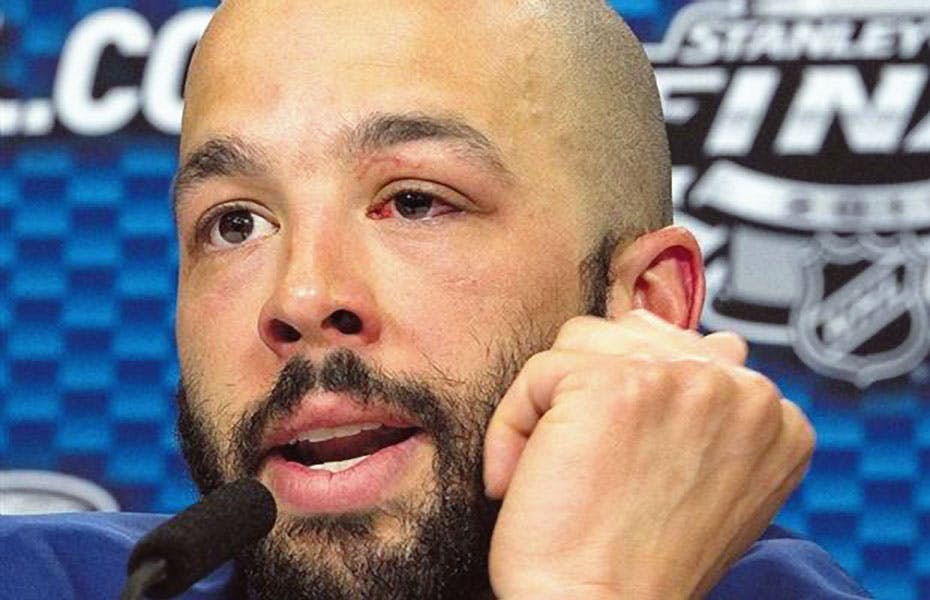Eye ball to Eye ball

"Manny’s eye is looking at you…over there…and over there…"
(Photo by Andy Clark, Reuters)
Manny Malhotra’s return has been labelled many things, mostly miraculous; whatever you want to call it, there are still things about his condition which should be pointed out. As someone who has dealt with (and still deals with) a serious vision issue, your esteemed author is in a position to shed some light on Malhotra’s future. Whether he is able to play in the coming weeks or just next fall is less important, the long term changes in his reaction speed to events to his left will be. Malhotra has sustained an injury to his eye which will take a long time to heal, no matter how well he has progressed these past few months.
Malhotra is going to be practically re-learning how to see. Malhotra’s ability to regain functionality will be an on-going challenge; his injured eye is going to slowly improve over time, but it will never return to what it was. This is the hardest part to contemplate – when we injure our ankle, we know it takes time to recover and at some point we feel it’s back to how it was. Injure your ankle again and you know the recovery takes a little longer, and you feel, just as before, that your ankle has returned to normal, again. Long term, however, you slowly become aware of the fact that your ankle often feels stiff, that you aren’t as flexible as you once were, that, in fact, your ankle isn’t the same as it once was. You recognize that the first time you sprained your ankle, the recovery wasn’t 100%, that you came almost all the way back, but you know it just wasn’t the same. Now apply this same process to an eye injury- there would be no doubt from the moment you felt your eye had recovered from injury that it was not the same as it once was. What’s worse, the eye doesn’t benefit from good circulation and so swelling takes a long, long time to reduce itself – you’ll notice that Malhotra’s eye is still notably swollen and red, it will gradually improve over the coming months.
Playing any sport with reduced vision in one eye and regular vision in the other is an interesting challenge. Often, it will be said ‘oh your depth perception must be gone’ or ‘how’s your peripheral vision, it must be a disaster’. The real challenge is different; it’s learning how to re-balance how your eyes and your brain combine the image. Depth perception is not going to be an issue – we learn to understand depth as children, and it is immaterial whether you have one eye or two. People who have lived since early childhood with limited vision in one eye generally find other ways of determining depth of field; depth perception mostly exists in the mind.
Depending on how much damage Malhotra sustained to his left eye, they may have fitted him with a special contact lens to help him focus images, but there’s no doubt that it will not be what it was before. Try this: while you read the next few lines, take a moment to notice the unconscious work your brain is doing as your eyes track each other across the page. You probably do most reading with your right eye, the left eye almost serves to confirm the first’s reading. If your let eye isn’t adding anything to the equation (like mine, and possibly Malhotra’s), it develops an annoying tendency to ‘over-shoot’ where you are reading. Playing sports, it’s not as much of a problem as the larger the object, the less fine detail you’ll need. The challenge instead is reacting to things to your left. You see the movement, but your reaction will be a fraction slower because the right eye will do the detail work. As time goes on, Malhotra’s brain will become more attuned to how his eyes work in their new configuration, and it will be less of a problem. For the next weeks, though, it will be interesting to see if Malhotra has any diminished reaction times to things happening to his left. We probably won’t notice it, but you never know.
If you are wondering, in my case, it was an infection in my left eye which, for a great while, seriously reduced the vision in my eye. Today, my left eye is much more useful than it once was, but I could never depend on it alone, the vision is still blurry, whereas I could depend solely on my right eye, which is as good as it ever was. It does great work complementing my right eye in my general vision, but anything involving detail (e.g. reading), my left eye is pretty much useless.
Patrick Johnston lives in Vancouver, bleeds Canucks blue and green (or is it yellow and red..or salmon…or…), and is pretty sure his 14 year old self could’ve done a better job than Rick Ley. You can follow him on twitter at twitter.com/risingaction
Recent articles from Patrick Johnston





